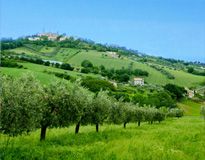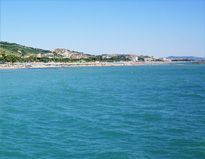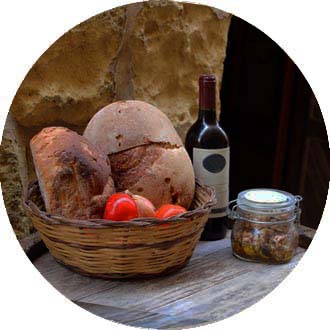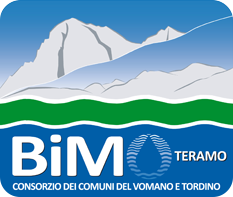Campli is a town of just over 7,000 inhabitants distributed in the capital and in more than thirty hamlets and districts, some also populous such as Sant'Onofrio and Campovalano.
Its territory is relatively extensive and borders to the north with Civitella del Tronto and Sant'Omero (thus arriving in Val Vibrata), to the south with Teramo, to the east with Bellante and to the west with Torricella Sicura and Valle Castellana.
Campli and its territory have been inhabited for thousands of years, just think of the important finds at Campovalano of the graves of Italic peoples dating back to the VI-V century BC. and which today are preserved in the necropolis and in the National Archaeological Museum of Campli. These findings have made a great contribution to the study of the Middle Adriatic civilization and its relations with the Etruscans and the Greeks. In Roman times it was a thriving crossroads of traffics, moreover placed in a strategic position, between Ascoli and Teramo, and some of its citizens were part of the Roman state structures, the most important of which, Lenate, was a very learned slave of Pompey and Tazio Lucio Rufus and reached the highest grades of the militia.
After the Roman era, certain news of Campli are found in the medieval period. In 1271 it was subdivided into two districts, while a few decades later, at the beginning of the fourteenth century, two other districts were added, following a marked increase in population, namely those of Castelnuovo and Nocella. In the Middle Ages, but also later for a certain period, Campli increased and consolidated its defensive structures, made of walls, ditches, drawbridges, towers, watch towers and several gates, located practically in every corner of the city. access to the village. In fact to the west, one entered the district of Nocella which was equipped with three doors, that is Porta da Capo, Porta da Piedi and Porta Sant'Angelo (of which today there are no more remains); the east area was guarded by the Castelnuovo district, with two gates, Porta di Capo Castello and Porta Orientale (or Angioina or San Giovanni), the only one still standing; at Campli, finally, it was accessed through four gates, namely Porta San Paolo (south), Porta San Salvatore (north), Porta Santa Chiara (west) and Porta del Castello (east), from which a fortified road departed with a fifth Door called the Purple Door.
The XIII and XIV centuries were very prosperous for Campli: it obtained the weekly market, its mayors were able to elect the judges, convents were built, hospitals, churches and doors, became a free Municipality (1372), the Church of Santa Maria in Platea came raised in Collegiata (1395) and much more.
Even later, however, growth and progress continued. In 1538 it passed from the State territory to Farnesian fiefdom, since it was granted to Margaret of Austria, daughter of Charles V and second marriage of Ottavio Farnese, duke of Parma and Piacenza, nephew of Pope Paul III. During the Farnese period, the village flourished, acquiring many advantages and privileges, attracting people and productive activities also from the surrounding area (even from Teramo), so much to increase the wellbeing to be totally immune from the famines and pestilences that caused thousands of victims in the rest of the Kingdom. This ascendant parable had one of the most prestigious moments in 1600, when Pope Clement VIII conferred the title of City to Campli and erected the Bishopric.
In 1703 there was a devastating earthquake that caused a lot of damage, destroyed a few houses and injured some public buildings, including the Parliament Building, while in 1734 Charles III of the Bourbon dynasty and son of Elisabetta Farnese happens on all the former Farnese States and therefore Campli too is incorporated into his Kingdom. In 1776 the Scala Santa was built, while in 1818 the Bishopric was suppressed following a concordat concluded between the Holy See and the Kingdom of the Two Sicilies and in 1860, in the framework of the war of unification of Italy, the city was attacked by the Bourbon troops and by the brigands who destroyed several public buildings, including the municipal archive.
Talking about Campli's cooking means talking about porchetta, that is, a centuries-old tradition and a very ancient art, so much so that information and news can be found from the Campli Statutes of 1575 and later.
In recent decades, this gastronomic peculiarity has been re-launched with the organization, every last weekend of August, of the pork festival, the oldest festival of Abruzzo and one of the first in Italy as the first edition was held in 1964 The festival also has its own online portal (http://www.sagradellaporchettaitalica.com/) in which, among the various information, is also reported the history of this dish.
- Battaglia
- Campiglio
- Campli (City)
- Campovalano
- Cappuccini
- Castelnuovo
- Cesenà
- Collicelli
- Fichieri
- Floriano
- Friscoli
- Gagliano
- Garrufo
- Guazzano
- Molviano
- Molviano Basso
- Nocella
- Paduli
- Pagannoni
- Pastinella
- Paterno
- Piancarani
- Piane a Canfora
- Piane Nocella
- Roiano
- Sant'Onofrio
- Traversa
- Trinità
- Villa Boceto
By Car
- From North and South
From the A14 exit at Teramo / Giulianova / Mosciano Sant'Angelo, take the SS80 towards Teramo, get to Teramo - Piazza Garibaldi, take Viale Bovio and continue straight following the signs for Campli. - From Pescara
Take the SS16 in the direction of Chieti, take the A14 and exit at Teramo / Giulianova / Mosciano Sant'Angelo. Take the SS 80 Strada Statale del Gran Sasso towards Teramo, get to Teramo - Piazza Garibaldi, take Viale Bovio and continue straight following the signs for Campli. - From Chieti
Take the SS81, take the A14, exit at Teramo / Giulianova / Mosciano Sant'Angelo, take the SS80 Strada Statale del Gran Sasso towards Teramo, get to Teramo - Piazza Garibaldi, take Viale Bovio and continue straight following the signs for Campli.
 en
en 


















